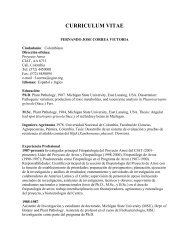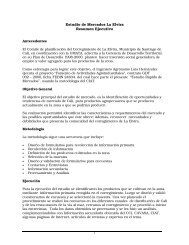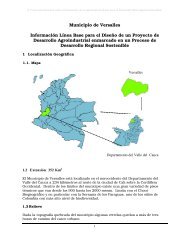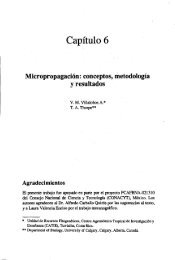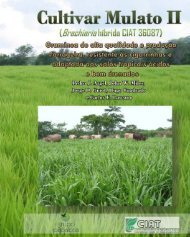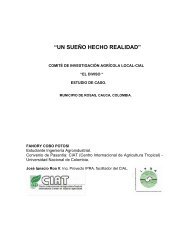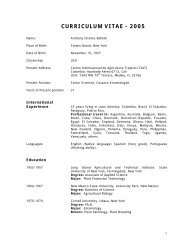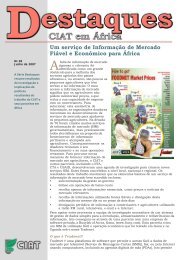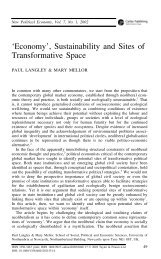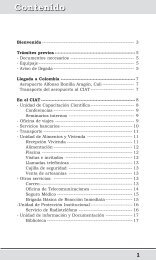Transgenic Cassava: The Products and Future Directions
Transgenic Cassava: The Products and Future Directions
Transgenic Cassava: The Products and Future Directions
You also want an ePaper? Increase the reach of your titles
YUMPU automatically turns print PDFs into web optimized ePapers that Google loves.
<strong>Transgenic</strong> <strong>Cassava</strong>: <strong>The</strong> <strong>Products</strong> <strong>and</strong><br />
<strong>Future</strong> <strong>Directions</strong><br />
Richard Sayre, Dept. Plant Cellular <strong>and</strong> Molecular Biology, Ohio State Univ. Columbus, OH,<br />
• Disease <strong>and</strong> Insect<br />
Resistance<br />
• Starch Production <strong>and</strong><br />
Modification<br />
• Enhancing Root Storage<br />
Proteins<br />
• Engineering Cyanogenesis<br />
• Engineering Protein<br />
Expression in Roots
Disease <strong>and</strong> Insect Resistant<br />
<strong>Cassava</strong><br />
• <strong>Transgenic</strong> cassava expressing an ACMV gene (in<br />
sense) provides cross-protection to a variety of related<br />
cassava mosaic viruses. Evidence that siRNAs are the<br />
mechanism of resistance. Entering field trials in Kenya.<br />
Nigel Taylor <strong>and</strong> Claude Fauquet<br />
• <strong>Transgenic</strong> cassava expressing RNAi constructs<br />
targeted to silencing ACMV effective in greenhouse<br />
trials. Zhang <strong>and</strong> Gruissem<br />
• <strong>Transgenic</strong> cassava expressing BT (control of cassava<br />
hornworm) goes into field trials in April at CIAT. Joe<br />
Tohme <strong>and</strong> colleagues.
Engineering Starches in <strong>Cassava</strong><br />
• A transgenic waxy starch (high<br />
amylopectin) cassava was reported at<br />
CBN V (2001) by Krit Raemakers <strong>and</strong><br />
Richard Visser is field trial in US Virgin Is.<br />
• Higher yielding transgenic cassava has<br />
been achieved by specifically expressing a<br />
bacterial AGPase in roots.
<strong>Cassava</strong> has tremendous untapped<br />
potential for increased starch<br />
production<br />
• Very high photosynthetic rate, approaching<br />
C4 plants.<br />
• Highest rate of sucrose synthesis measured<br />
to date.<br />
• In the greenhouse excess sucrose is lost<br />
through gutation; represents a lost source of<br />
carbohydrate.<br />
• Large starch storage organs.
Hypothesis<br />
Root-specific expression of a<br />
modified (K296E/G336D)<br />
bacterial glgC gene encoding a<br />
more active ADP-glucose<br />
pyrophosphorylase (AGPase<br />
catalyzes the rate-limiting step in<br />
starch synthesis) will result in,<br />
1) increased carbohydrate sink<br />
strength in roots,<br />
2) reduced feedback inhibition<br />
on photosynthetic carbon<br />
fixation<br />
3) increased starch production.<br />
<strong>Transgenic</strong>
Plasmid WT 3D-1 3D-2 3D-3 3D-4 3D-5 Marker<br />
<strong>The</strong> glgC gene is expressed in roots of<br />
transgenic cassava. RT-PCR analysis<br />
demonstrates expression of glgC gene.<br />
350 bp
RT-PCR analysis of glgC <strong>and</strong> CYP79 (D1)<br />
expression demonstrates that the patatin-glgC<br />
construct is not expressed in leaves.<br />
350 bp<br />
650 bp<br />
P WT 3D-1 3D-2 3D-3 M<br />
glgC<br />
CYP79<br />
(D1)
PPi + ADP-Glucose Glucose-1-P +ATP<br />
6-phosphogluconolactone Glucose-6-P<br />
ug NADPH /mg protein/hr<br />
0.6<br />
0.5<br />
0.4<br />
0.3<br />
0.2<br />
0.1<br />
0.0<br />
NADPH NADP +<br />
Control 3D-1 3D-2 3D-3<br />
AGPase activity is elevated two-fold in transformed<br />
plants expressing the glgC gene.
Plants expressing the glgC gene have more than<br />
twice the root biomass (dry weight) of wild-type<br />
plants.<br />
Cultivar→<br />
(relative AGPase<br />
activity)<br />
Leaves (g)<br />
(% WT)<br />
Stems (g)<br />
(% WT)<br />
Stem-Root<br />
Junction (g)<br />
(% WT)<br />
Roots (g)<br />
(% WT)<br />
Wild Type<br />
(100)<br />
55.1+/-8.3 a<br />
(100)<br />
89.7+/-5.0 c<br />
(100)<br />
16.7+/-1.5 b<br />
(100)<br />
18.9+/-4.3 c<br />
(100)<br />
3D-1<br />
(200)<br />
68.6+/-4.0 a<br />
(123)<br />
148+/-8.8 a<br />
(165)<br />
25.4+/-2.5 a<br />
(156)<br />
48.2+/-9.3 a<br />
(266)<br />
3D-2<br />
(100)<br />
60.4+/-0.84 a<br />
(109)<br />
114+/-25.3 bc<br />
(128)<br />
25.2+/-2.7 a<br />
(156)<br />
24.9+/-7.8 bc<br />
(133)<br />
3D-3<br />
(160)<br />
62.5+/-9.4 a<br />
(112)<br />
134+/-14 ab<br />
(150)<br />
23.1+/-3.6 ab<br />
(143)<br />
28.5+/-8.7 b<br />
(155)<br />
6 month greenhouse study. Values with different letters are significantly different from each other.
Summary<br />
• <strong>Transgenic</strong> cassava having two-fold higher<br />
AGPase activity have been successfully<br />
engineered.<br />
• <strong>Transgenic</strong> plants having higher AGPase<br />
levels produce more than twice the root<br />
biomass of control plants.<br />
• Total biomass of transgenic plants also<br />
increased possibly reflecting a release of<br />
feed-back inhibition on photosynthesis.
Expression of an Artificial Storage Protein 1<br />
(ASP1) in cassava leaves <strong>and</strong> roots.<br />
Amino Acid<br />
Composition<br />
Arg 3.2%<br />
Glu 16.8%<br />
Gly 6.3%<br />
Ile 9.5%<br />
Leu 8.4%<br />
Lys 17.9%<br />
Met 12.6%<br />
Phe 4.2%<br />
Pro 3.2%<br />
Thr 9.5%<br />
Trp 3.2%<br />
Val 5.3%<br />
Zhang Peng <strong>and</strong> Willi Gruissem, ETH, Zurich, Switzerl<strong>and</strong><br />
ASP1 is enriched in essential amino acids that<br />
are limiting in cassava <strong>and</strong> was designed to<br />
mimic stable storage albumin proteins.<br />
ASP1 traits:<br />
• Four, 20 amino acid, amphipathic helical<br />
repeats connected together by three β-turns.<br />
• Tertiary structure is stabilized by Glu-Lys salt<br />
bridges.<br />
• Predicted size = 7.5 kD; pI = 9.35.<br />
Zhang et al. (2003) Transgen. Res. 12: 243-250
Western blot analysis of ASP1<br />
expression (35S) in leaves <strong>and</strong> roots.<br />
Leaves<br />
HIGH<br />
Roots<br />
LOW<br />
Zhang et al. (2003) Transgen. Res. 12: 243-250
Changes in leaf protein amino acid content of<br />
plants expressing ASP1.<br />
• Amino acids having elevated levels in leaves of ASP1<br />
transgenic plants included:<br />
– Arg (5-30%)<br />
– Ile (2-5%)<br />
– Pro (5-10%)<br />
– Ser (10%)<br />
– Thr (2-8%).<br />
• Amino acids having reduced levels in leaves of ASP1 trangenic<br />
plants included:<br />
– Tyr (5%)<br />
– Met (2-8%)<br />
– Ala (6-12%)<br />
– Glu (5%)<br />
– Asn (20-22%)<br />
• Expected results: Higher Arg, Glu, Ile, Leu, Met, Lys, Phe, Thr,<br />
Pro, Trp, Val, Gly<br />
• Results from roots presented on poster by Zhang et al..
Engineering cyanogenesis in<br />
transgenic cassava<br />
Dimuth Siritunga <strong>and</strong> Richard Sayre, Dept. of Plant Cellular <strong>and</strong><br />
Molecular Biology, Ohio State Univ., Columbus, OH 43210 USA<br />
• Inhibition of cyanogenic glycoside<br />
synthesis may be lethal to cassava.<br />
• Acceleration of cyanogen turnover.<br />
Siritunga D <strong>and</strong> Sayre RT (2003) Planta 217: 367-373.<br />
Siritunga et al. (2004) Plant Biotechnology Journal 2: 37-43
Target enzymes for regulating cyanogen synthesis<br />
<strong>and</strong> turnover in transgenic cassava<br />
Valine<br />
N-hydroxyvaline<br />
2-Methyl proponol oxime<br />
Acetone cyanohydrin + UDPG<br />
Linamarin<br />
Glucose + Acetone cyanohydrin<br />
Acetone + HCN<br />
CYP79D1<br />
CYP79D2<br />
CYP71E<br />
UDPG-glucosyl<br />
transferase<br />
Linamarase<br />
Hydroxynitrile lyase<br />
(or spontaneously)
Agrobacterium-mediated Agrobacterium mediated transformation<br />
Antisense inhibition of<br />
CYP79D1/D2 expression<br />
using leaf-specific Cab1<br />
promoter<br />
Antisense inhibtion of<br />
CYP79D1/D2 expression<br />
using tuber-specific<br />
Patatin promoter<br />
Siritunga <strong>and</strong> Sayre (2003) Planta 217: 367-373
LEAF linamarin levels were reduced between 60%<br />
<strong>and</strong> 94% in Cab1-CYP79D1/D2 Cab1<br />
transformants<br />
% Linamarin<br />
100<br />
80<br />
60<br />
40<br />
20<br />
0<br />
11.3<br />
29.4<br />
23.5<br />
40.5<br />
6.2<br />
WT Cab1-1 Cab1-2 Cab1-3 Cab1-4 Cab1-5<br />
80<br />
70<br />
60<br />
50<br />
40<br />
30<br />
20<br />
10<br />
0<br />
Linamarin (umoles/gdw)
Surprise, root linamarin levels in Cab1-CYP79D1/D2<br />
transformants were < 1% of wild-type levels!<br />
% Linamarin<br />
100<br />
99<br />
98<br />
97<br />
96<br />
2.5<br />
2.0<br />
1.5<br />
1.0<br />
0.5<br />
0.0<br />
0.98<br />
0.29<br />
0.26<br />
0.33<br />
0.73<br />
WT Cab1-1 Cab1-2 Cab1-3 Cab1-4 Cab1-5<br />
3.40<br />
3.36<br />
3.32<br />
3.28<br />
0.08<br />
0.06<br />
0.04<br />
0.02<br />
0.00<br />
Linamarin (umoles/gdw)
How can ROOT linamarin levels be reduced<br />
in Cab1-CYPD1/D2 antisense plants?<br />
Two options……….<br />
1. Cab1 promoter, although leaf-specific, might be<br />
‘on’ on’ in cassava.<br />
Or<br />
2. Root linamarin is synthesized in leaves <strong>and</strong><br />
transported to the roots.
• No suppression of CYP79 expression in roots driven by<br />
cab1 promoter (not shown).<br />
• No reduction in leaf or root linamarin levels in patatin-<br />
CYP79D1/D2 antisense plants. Linamarin is transported!<br />
% Linamarin<br />
100<br />
80<br />
60<br />
40<br />
20<br />
0<br />
Pat1 Pat2 Pat3 WT<br />
Leaves<br />
Roots
Summary<br />
• Inhibition (> 60%) of linamarin synthesis in leaves<br />
results in no linamarin accumulation in roots.<br />
• Inhibition of CYP79D1/D2 expression in roots has<br />
no effect on root linamarin levels.<br />
• Root linamarin is made in leaves <strong>and</strong> transported to<br />
roots.<br />
• <strong>The</strong> function of root CYP79D1/D2 activity is<br />
unclear.
Accelerating cyanogen turnover in processed<br />
cassava maintains the benefits of cyanogens<br />
<strong>The</strong> major cyanogen present in poorly processed cassava roots is<br />
acetone cyanohydrin, not linamarin.<br />
<strong>Cassava</strong> roots have virtually no HNL activity (0 - 6% of leaf<br />
levels) possibly accounting for high acetone cyanohdrin levels<br />
Elevated expression of HNL in roots is predicted to accelerate<br />
the conversion of acetone cyanohydrin to cyanide <strong>and</strong> the<br />
detoxification (cyanide volatilization) of cassava root starch.<br />
LB<br />
2X35S Rbcs Ter Nos Ter Kan r Nos Prom<br />
RB<br />
Siritunga et al. (2004) Plant Biotechnology Journal 2: 37-43
Accelerating cyanogenesis in cassava<br />
Valine<br />
N-hydroxyvaline<br />
2-Methyl proponol oxime<br />
Acetone cyanohydrin + UDPG<br />
Linamarin<br />
Glucose + Acetone cyanohydrin<br />
Acetone + HCN<br />
CYP79D1<br />
CYP79D2<br />
Putative<br />
CYP71E<br />
UDPG-glucosyl<br />
transferase<br />
Linamarase<br />
Hydroxynitrile lyase<br />
(or spontaneously)
Root hydroxynitrile lyase (HNL) activity in wildtype<br />
<strong>and</strong> transformed plants<br />
Specific Activity (umoles CN/mg protein/hr)<br />
350<br />
300<br />
250<br />
200<br />
150<br />
100<br />
50<br />
0<br />
WT HNL-1 HNL-2 HNL-3
Reduction in root acetone cyanohydrin levels in<br />
processed roots of plants expressing elevated HNL<br />
activity.<br />
ACN (umoles/gfw)<br />
3.0<br />
2.5<br />
2.0<br />
1.5<br />
1.0<br />
0.5<br />
0.0<br />
Wild type<br />
HNL-1<br />
HNL-2<br />
HNL-3<br />
0 20 40 60 80 100 120<br />
Time (minutes)<br />
100 %<br />
59 %<br />
49 %<br />
35 %
Summary<br />
• <strong>The</strong> absolute increase in HNL activity was 10-fold<br />
greater in leaves than in roots of transgenic plants.<br />
• A 13-fold increase in root HNL activity was<br />
achieved, however, the absolute increase in enzyme<br />
activity was small.<br />
• Over-expression of HNL in roots accelerates<br />
cyanogenesis by more than 3-fold <strong>and</strong> facilitates<br />
cyanogen removal <strong>and</strong> food detoxification.
Why is it difficult to express proteins in<br />
roots of cassava?<br />
• Transcriptional control: Strong root promoters<br />
(1-2X 35S <strong>and</strong> patatin) do not deliver<br />
expression levels comparable to leaves.<br />
• Post-translational: No evidence for<br />
accelerated protein turnover from westerns.<br />
• Translational: Limiting free amino acid pool<br />
sizes for protein synthesis.
It is easier to over-express proteins in<br />
leaves than roots when using strong<br />
Enzyme Activity<br />
(mMol CN/mg protein/hr)<br />
Hydroxynitrile lyase<br />
(HNL)<br />
HNL-transgenic<br />
2X35S promoter)<br />
promoters (2X35S).<br />
Root<br />
Activity<br />
0.025<br />
0.325<br />
Leaf<br />
Activity<br />
1.7<br />
4.0<br />
Leaf<br />
minus<br />
Root<br />
Activity<br />
1.68<br />
3.68<br />
Root/Leaf<br />
Ratio<br />
0.02<br />
0.08
Free amino acid pool sizes in cassava roots<br />
are low <strong>and</strong> may limit protein production<br />
• <strong>The</strong> root/leaf free amino acid pool size<br />
ratio in cassava is 1:6. <strong>Cassava</strong> roots <strong>and</strong><br />
leaves typically have 1% <strong>and</strong> 6-10%<br />
protein, respectively.<br />
• <strong>The</strong> root/leaf ratio of free amino acids in<br />
wild cassava relatives having high (8%)<br />
root protein content is 1:4.2<br />
(Martin Fregene, personal communication).
Invariably, enzymes that are expressed in cassava leaves <strong>and</strong><br />
roots have 10-20 fold higher activity levels in leaves than in<br />
roots with the exception of CN-assimilating enzymes.<br />
Enzyme<br />
Hydroxynitrile lyase (HNL)<br />
HNL-transgenic (35S promoter)<br />
Linamarase<br />
β-cyanoalanine synthase<br />
β-cyanoalanine hydrase<br />
Asparaginase<br />
Root/Leaf<br />
Activity Ratio<br />
0.02<br />
0.08<br />
0.05<br />
1.39<br />
2.84<br />
0.70
Linamarin is a transportable form of reduced<br />
nitrogen for amino acid <strong>and</strong> protein synthesis in<br />
cassava roots<br />
• Linamarin accounts for 60% of the total nitrogen in phloem<br />
exudates of wild-type plants.<br />
• Roots of Cab1 - CYP79D1/D2 antisense plants will not grow<br />
if supplied nitrate as the sole source of nitrogen.<br />
• Addition of ammonia to growth media restores root growth to<br />
Cab1 – CYP79D1/D2 antisense plants.<br />
• In contrast, Patatin – CYP79D1/D2 antisense plants grow as<br />
well as WT plants in media containing nitrate as the sole<br />
source of nitrogen.<br />
• Conclusion: <strong>The</strong> absence of root linamarin necessitates<br />
an alternate source of reduced nitrogen for root growth
Biochemical evidence for cyanide as a source<br />
of reduced nitrogen for amino acid synthesis<br />
in cassava<br />
• Nartley observed in 1969 that germinated cassava<br />
seedlings exposed to 14 CN incorporated 49% of the label<br />
into the amide C of asparagine <strong>and</strong> 6% in aspartate.<br />
• Some 14 CN was also incorporated into glutamine <strong>and</strong><br />
glutamate via aspartate deamination <strong>and</strong> cycling of carbon<br />
through the TCA cycle.<br />
• <strong>The</strong> most abundant free amino acids in cassava seedlings<br />
are asparagine <strong>and</strong> glutamine. Cysteine could not be<br />
detected.<br />
• Conclusion: CN is probably assimilated into free<br />
amino acids concomitant with the consumption of<br />
cysteine.<br />
Nartley F. (1969) Physiol. Plantarum 22: 1085-96.
Diversion of linamarin from storage to amino acid synthesis could<br />
increase amino acid pool sizes <strong>and</strong> protein synthesis in roots<br />
Linamarin<br />
Linamarin<br />
Export<br />
Linamarin<br />
Storage<br />
Valine<br />
Linamarin<br />
Storage<br />
Acetone cyanohydrin<br />
Linamarin can be stored in roots<br />
or used for protein synthesis.<br />
CN - + Cysteine<br />
β-cyanoalanine + H 2 O<br />
Asparagine<br />
Aspartate + NH 3<br />
β-cyanoalanine<br />
synthase<br />
β-cyanoalanine<br />
hydrase<br />
Asparaginase
1. RT-PCR RT PCR analysis of ROOT CYP79D1/D2 transcript<br />
levels in Cab1 transformants indicates the Cab1<br />
promoter is not ‘on on’ in roots.<br />
Wild Type<br />
Cab1-1<br />
Cab1-2<br />
Cab1-3<br />
Cab1-4<br />
Cab1-5<br />
- control<br />
+ control<br />
700bp CYP79D1<br />
550bp CYP79D2<br />
SBE II gene
RT-PCR RT PCR demonstrates the reduction or complete loss of<br />
CYP79D1/D2 transcripts in leaves of Cab1- Cab1<br />
CYP79D1/D2 antisense plants.<br />
WT<br />
Cab1-1<br />
Cab1-2<br />
Cab1-3<br />
Cab1-4<br />
Cab1-5<br />
- control<br />
+ control<br />
700bp CYP79D1<br />
550bp CYP79D2<br />
SBE II gene<br />
RT-PCR on 8µg of <strong>Cassava</strong> Cab1 transformant total leaf RNA. CYP79D1/D2<br />
gene specific primers amplify the 3’-end of the respective genes.
2. CYP79D1/D2 expression is inhibited in ROOTS of patatin- patatin<br />
CYP79D1/D2 antisense plants.<br />
Pat-2<br />
Pat-1<br />
Pat-3<br />
Pat-2<br />
Pat-1<br />
Pat-3<br />
WT - +<br />
WT - +<br />
CYP79D1<br />
CYP79D2<br />
SBE II<br />
CYP79D1<br />
CYP79D2<br />
SBE II<br />
Root RT-PCR RT PCR<br />
shows<br />
elimination of<br />
root<br />
transcripts<br />
Leaf RT-PCR<br />
shows little or<br />
no effect on<br />
leaf transcript<br />
levels
PCR amplification of patatin/glgC gene border<br />
in transgenic (3D) cassava<br />
Plasmid WT 3D-1 3D-2 3D-3 3D-4 Marker<br />
.<br />
• the fidelity of the PCR product was confirmed by DNA sequence<br />
analysis.<br />
850 bp
UDP-Glucose +<br />
Fructose-6-P<br />
Rate Limiting Step<br />
ADP-Glucose<br />
sucrose phosphate synthase<br />
AGPase<br />
Sucrose-6-P +<br />
UDP + H +<br />
Sucrose<br />
invertase<br />
Fructose + Glucose<br />
Glucose-1-P
Leaves <strong>and</strong> roots of transgenic plants have<br />
greater mass per unit than wild type.<br />
Plants Ratio of leaf<br />
weight/leaf<br />
number<br />
WT 2.40 10.57<br />
3D-1 2.72 16.58<br />
3D-2 2.6 14.13<br />
3D-3 2.62 11.20<br />
Ratio of root<br />
weight/root<br />
number
T-DNA containing modified glgC gene with an Nterminal<br />
chloroplast transit peptide.<br />
RB<br />
850bp<br />
Patatin TP<br />
glgC nos polyA<br />
1.2kb 1.3kb<br />
<strong>The</strong> red box corresponds to the unique T-DNA region<br />
amplified by PCR for identification of transgenic<br />
plants.<br />
LB
Limiting free amino acid pool sizes<br />
affect protein synthesis in plants<br />
• Due to limiting amino acid pool sizes, expression of a sulfurrich<br />
sunflower seed albumin gene (accounting for 7% of<br />
total seed protein) in transgenic rice resulted in no net<br />
change in the total amount of sulfur-containing amino acids.<br />
(Hagan et al., (2003) Pl. J. 34: 1-11).<br />
• Enhancing the expression of sulfur-rich proteins in peas was<br />
dependent on the pool sizes of free Cys <strong>and</strong> Met. (Tabe et al.<br />
(2002) Cur. Opin. Pl. Biol. 5: 212-217).<br />
• Expression of threonine <strong>and</strong> methionine rich proteins in<br />
transgenic tobacco having 15-fold <strong>and</strong> 3-fold higher<br />
threonine <strong>and</strong> methionine levels, respectively, was limited<br />
by the pool sizes of other amino acids. (Karchi et al. (1993) Pl. J. 3:<br />
721-727).
Cyanogen catabolism <strong>and</strong> amino acid synthesis in<br />
roots<br />
Linamarin<br />
Linamarin<br />
Valine<br />
Linamarin<br />
Acetone cyanohydrin<br />
Linamarin can be stored in roots<br />
or used for protein synthesis.<br />
CN - + Cysteine<br />
β-cyanoalanine + H 2 O<br />
Asparagine<br />
Aspartate + NH 3<br />
β-cyanoalanine<br />
synthase (1.4x)<br />
β-cyanoalanine<br />
Hydrase (3X)<br />
Asparaginase<br />
(0.7X)
GBSS<br />
SSS<br />
ADP-Glucose<br />
sucrose phosphate synthase<br />
UDP-Glucose +<br />
Fructose-6-P<br />
Rate Limiting Step<br />
In Starch Production<br />
AGPase<br />
Sucrose-6-P +<br />
UDP + H +<br />
Sucrose<br />
invertase<br />
Fructose + Glucose<br />
Glucose-1-P<br />
+ ATP
ENGINEERING CASSAVA FOR INCREASED<br />
STARCH PRODUCTION<br />
Uzoma E. Ihemere 1 <strong>and</strong> Richard T. Sayre 2<br />
Dept. of Horticulture & Crop Science 1 <strong>and</strong> Dept. of Plant Cellular <strong>and</strong> Molecular Biology 2<br />
Ohio State University, Columbus, OH 43210 USA<br />
Ihemere et al. (2004) in preparation for Plant Physiology



